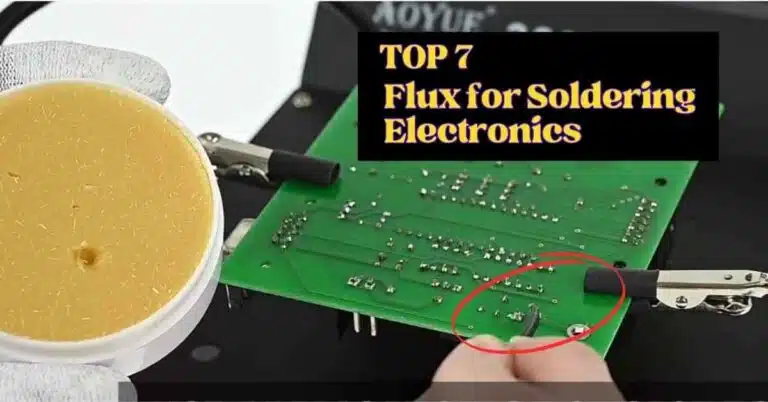Choosing the right Flux for Soldering is vital to maximizing product yield and building customer relationships. From removing other metallic impurities to preparing a clean surface for solid jointing, the best Flux for Soldering Electronics can help you meet your goals.
To find out the best electronics flux for Soldering, I handpicked the best available product in the marketplace. In this guide, you can find the list of the top good flux shortlisted after several hours of product research, testing, and analysis.
Related Read: 5 Best Microscopes for Mobile Repairing Reviewed (2024)
When I explored it to test during the workshop, several students asked many questions about it. I have prepared this comprehensive list after consulting with more than ten soldering experts. You can get the best flux options to fulfil your project needs. The SRA Soldering Products are a great choice for high-quality flux for soldering electronics at a reasonable price.
Table of Contents
How we tested and Picked
I spend thousands of hours testing, analyzing, and researching products to help find you a solution to fulfill project needs. The cost of soldering flux is meager, and you can get less than 10 dollars. It is the reason I purchased them all for testing.
I have researched independently and unbiasedly to find flux for soldering electronics. I have considered a few key factors while considering the best options. The factors are pricing, ease of use, and customer feedback and reviews. I have analyzed several online reviews through automated AI tools.
After using a ton of different fluxes for Soldering Electronics and individually testing based on their performance and ease of use, I’ve selected the best ones to buy. Below is the list of 7 Best Electronics Fluxes for Soldering. Here, you can find the top Flux for Soldering Electronics shortlisted after several hours of product research, testing, and analysis. I have selected these top-rated fluxes to help you choose the most suitable for your project needs.
In searching for the best flux for micro soldering, I have compared more than 20 models based on the following criteria:
Hands-on testing:
To find out the best of the lot products, I have tested more than 20 types of fluxes. I weed out faulty products and hand-pick the best available options.
Reliability Research:
I have collected reviews from thousands of product owners. I analyzed each of the product reviews and customer feedback. Based on that, I listed the most popular models that work faster than others.
Safety:
While choosing a good Flux, always consider the safety of both personnel and the plant. It is a crucial factor to consider when making the final purchasing decision.
Best Flux for Soldering Electronics in 2024?
The best soldering flux on the market is the SRA Soldering and MG Chemicals. They are the best because they are of strong applicability, are easy to use, and are great for all electronics. Let’s first talk about these top fluxes in detail in this article.
- Best Overall: SRA Soldering Products Rosin Paste Flux
- Best Electronics Repairs: MG Chemicals 8341 No Clean Flux Paste
- Best for stainless steel: 8oz Liquid Zinc Flux for Stained Glass
- Best for soldering copper: LA-CO 22194 -Copper Flux Paste for Soldering
1. SRA Soldering Products Rosin Paste Flux
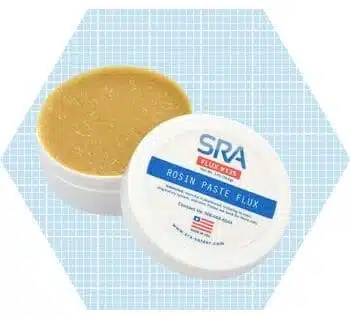
One of the best things I noticed with this Rosin Paste Flux is that it does not contain Zinc Chloride or Ammonium Chloride. Instead, it includes Rosin and an organic acid activator for the best soldering quality and healthy joint formations.
It is one of the best fluxes for electronics I’ve used when working as a PCB repair expert. I like this flux Because It is one of the most popular and ideal fluxes for electrical and electronic repairs. I also like it because it is made in the USA. So it offers high quality. That is why I included it in the list of good flux for soldering electronics.
When I used it for repairing PCBs, I found it easy to use and reliable at an affordable price. That is why I like and recommend SRA Soldering for soldering electronics. I like it because It is ideal for repairing electronic products. One of the key highlights I have noticed is the need for a minimum cleaning surface after Soldering. I also like it because its operating temperature ranges are pretty good.
I also like SRA Soldering Products because they are made in the USA. It is the highest rated on Amazon, according to customer reviews. I want to share more than this product on leaded and lead-free solder paste applications. It is Ideal for suitable flux for micro Soldering, electrical, SMD, and PCB repairs.
Best Features:
- Formulated for use with tin/lead and lead-free alloys ideal for electronic repairing.
- This Best flux for SMD soldering acts at a temperature range of 93 – 315° and does not require cleaning of surfaces.
- This product comes in a 2-oz hockey puck jar pack size.
Pros:
- Made in the USA Quality Product.
- It offers a warranty for long-term usage.
- Works great with lead-free, lead, and tin alloys.
Cons:
- Has only downside is that it lacks RoHS compliance.
2. MG Chemicals 8341 No Clean Flux Paste
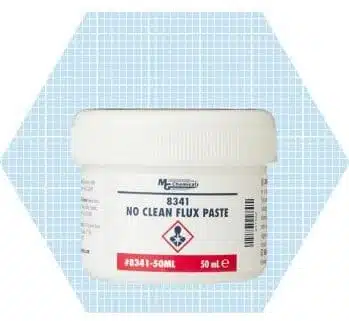
Once, I worked on a project when I was in Germany. The Customer provided me with this solder flux paste and asked me to repair the circuit boards. I found this flux very easy to use and had better performance.
This liquid soldering flux for electronics is another excellent option. It is the best flux for SMD soldering, especially for touch-up and repair activities. If I talk about the composition, MG Chemicals 8341 is made of high-grade synthetic resin and thixotropic agents.
One of the best things I noticed is that this No Clean Flux Paste MG Chemicals 8341 fulfils the ROHS Complaint. It follows the IPC-J-STD-0048 standards.
I also liked that it had an excellent wetting performance. I also like its completely halogen-free option—it leaves very little residue after rework and repair activities. Furthermore, I appreciate how a unique mixture of high-grade synthetic resin is the perfect solder flux for electronics for high-temperature lead-free soldering jobs.
Best Features:
- Convenient and compatible with a syringe dispenser application.
- Ideal and Best flux for SMD soldering repair and rework activities.
- flux for soldering electronics. Key highlights include fast wetting, low residues, and halogen-free composition.
Pros:
- It offers high-quality soldering capabilities.
- Long warranty for long-term usage.
- Works great with lead-free, lead, and tin alloys.
Cons:
- Its Downside is its more expensive price range compared to other flux types.
3. LA-CO 22194 -Copper Flux Paste for Soldering

I liked the LA-CO 22101 Soldering Flux Paste, an affordable Regular Soldering Flux Paste option. It is a water-soluble paste that meets industry standards. This Soldering Flux Paste offers many advanced features and is the best solder for copper and brass soldering jobs. It is also recommended for other advanced applications.
I also liked that LA-CO 22101 is a water-soluble option, which means it is a more effective reactive cleaner than other rosin fluxes. I noticed that it is safe to use, and the flux for soldering electronics is lead-free, non-acidic, and non-toxic.
Furthermore, I appreciate that MG Chemicals complies with ASTM B813 standards and does not include zinc chloride. It also helps to remove corrosion issues efficiently. I recommend it as the best soldering option for copper pipe and metal welding. The pros and cons are given below.
Best Features:
- Best liquid soldering flux for electronics made in the USA.
- It eliminates safety concerns due to being acidic and nontoxic.
- Non-acidic but best recommended for soldering for copper soldering.
- Key highlights include fast wetting, low residues, and halogen-free composition.
Pros:
- It is an excellent, made-in-USA quality.
- Versatile and compatible with several types of metals.
- Works great with lead-free, lead, and tin alloys.
Cons:
- Its Downside is its lack of warranty.
4. RadioShack Rosin Soldering Flux Paste

I like RadioShack Rosin because it is a premium choice for electrical and electronic repairs. It is another excellent Made in the USA best flux for electronics. When I checked the customer service, I found it satisfactory.
RadioShack is the best flux for electrical and electronics repairs because of its reliable, USA-quality products. It is an excellent premium-grade flux to produce strong solder joints. I have used it for decades, and it helps me remove surface oxides and has excellent cleaning properties.
The Soldering Flux Paste is ideal for solid and smooth soldering joints. RadioShack is a trendy brand that provides quality products and accessories. I got 2 oz of soldering flux inside the delivery pack when I purchased it.
When I look at a list of features, it’s elementary to clean due to the No-spill formulation. Some users received it with the seal broken. I am of the downside that this product.
Best Features:
- This flux is easy to clean by wiping with a cloth or cleaning solvent.
- Includes a warranty period of 90 days; it is suitable for satisfaction.
- It eliminates safety concerns due to its non-acidic and nontoxic nature.
Pros:
- It is an excellent, made-in-USA quality.
- Versatile and compatible with several types of metals.
- Works great with lead-free, lead, and tin alloys.
Cons:
- Its Downside is its lack of warranty.
5. Delcast Rosin soldering flux
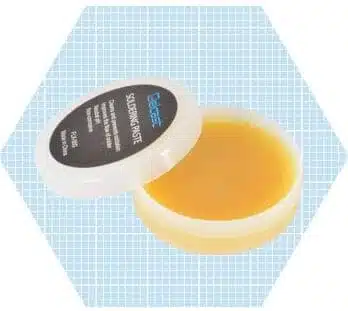
The Delcast Rosin solder flux is a perfect selection if you seek the soldering flux for mobile and printed circuit board repair. The best flux for circuit boards must be made of natural rosin-derived materials. Field professionals and I recommend it as the best option for PCB and electrical Soldering.
ACCORDING TO EXPERTS, when I asked for expert recommendations and reviews, it is an ideal solder flux for cell phone repair. It is also widely recognized by users of all experience levels.
I also appreciate how Delcast Rosin solder flux for electronics provides more controlled and accurate soldering joints.
I also noticed that the Delcast Rosin solder flux for electronics allows the solder to form strongly and reach the solder where the flux is applied. It is the best flux for electrical Soldering and a very reliable solder flux at affordable prices.
Best Features:
- Flux facilitates solder flow, providing for more controlled and accurate Soldering.
- Allows the solder to form strong, long-lasting mechanical and electrical bonds
- It prevents corrosion by forming a protective coating over the solder joint.
- It eliminates safety concerns due to its non-acidic and nontoxic nature.
Pros:
- Helps to form strong, long-lasting mechanical Joints.
- Versatile and compatible with several types of metals.
- Works great with lead-free, lead, and tin alloys.
Cons:
- Its Downside is its lack of warranty.
6. 8oz Liquid Zinc Flux for Stained Glass
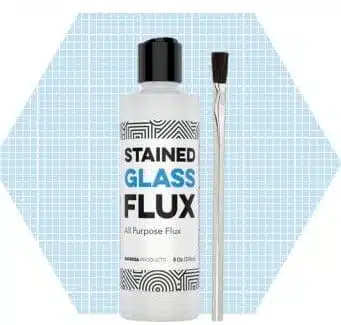
Last but not least, our flux for soldering electronics is 8oz Liquid Zinc Flux for Stained Glass Paste. It is an excellent Premium Grade RA Flux with fast wetting availability. MG Chemicals deals with premium-quality chemicals related to the electronics industry.
8oz Liquid Zinc Flux is the best flux for soldering stainless steel. It is formulated with high-activity Zinc Chloride, which is strong enough that general rosin flux won’t work well for soldering. According to the experts, the most active flux is highly recommended for soldering stainless steel.
Regarding studs, the flux for soldering electronics can be used with both leaded and lead-free solders. The flux is RoHS-compliant and provides excellent wetting. During my Hand soldering practice, I applied the flux through brushing, cotton swabs, or dipping.
Related Read: Best Stained Glass Soldering Iron in 2023 (My Top Picks)
Furthermore, I found it the perfect selection for reworking and repairing PCBs and surface mount assemblies. In other favourable words, it is the best flux for SMD soldering. It is also vital in the repair and troubleshooting of general electronic repairs.
Best Features:
- It is an all-purpose Brazing Flux with low temperature.
- Zinc Chloride or Ammonium Chloride free, Best soldering flux
Pros:
- It is an excellent low-temperature flux.
- Versatile and compatible with several types of metals.
- Works great with lead-free, lead, and tin alloys.
Cons:
- Its Downside is its lack of warranty.
7. Harris SSWF1 Stay Silver Brazing Flux
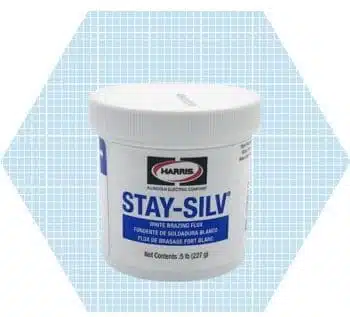
It is an excellent option for those who require silver brazing for ferrous and nonferrous metals soldering jobs. This Silver White Brazing Flux is an all-purpose product. I like its low-temperature feature, ideal for brazing copper, brass, steel, stainless steel, and nickel alloys.
The best flux for the silver solder brazing process is Harris SSWF1 because it is made of low-temperature silver-alloy filler metals. The low-temperature filler metals help to minimize oxidation during the brazing process. That ultimately leads to creating solid, high-quality brazed joints.
According to the project needs, the Harris Flux is a further subcategory in Stay-Silv White Brazing Flux, Stay-Silv Powder Brazing Flux, and Stay-Silv Black Brazing Flux. During the Investigation, I found the company’s excellent customer service. They’re readily available and willing to answer any questions related to product and technical aspects.
The Harris Products Group produces flux electronics with an Active range of 1050°F – 1600°F. It is mainly recommended for silver brazing jobs. So, I found the silver brazing applications.
Best Features:
- Flux liquid for all-purpose brazing with low temperature used for Soldering.
- Use with most ferrous and nonferrous metals. It is not recommended for aluminum, magnesium, and titanium.
Pros:
- It is an excellent cleaning quality.
- Versatile and compatible with several types of metals.
- Works great with lead-free, lead, and tin alloys.
Cons:
- Its Downside is its lack of warranty.
How To Use Electronic Solder Flux
Electronic solder flux is crucial to making solid and shiny joints when working with electronics. Before beginning the exercise, you must prepare your soldering iron by heating it to the appropriate temperature, cleaning the iron tip, and placing it on a stand.
When the iron’s tip is hot, apply a small amount of solder and clean it with a sponge, tinning the tip with solder. Tinning helps the recommendation reduce wear, protect from oxidation, and improve heat transfer.
Step 1: It is always good to scrub the two pieces you wish to solder with steel wool or scotch brite, which helps remove oxide layers on the surface.
Step 2: Use a brush to apply the electronic flux with solder to both pieces of the terminal that need to be joined.
Step :3 Without burning away the flux, heat the joint with a soldering iron with the help of an adjustable temp control and set the iron to the proper temperature (400′ C/ 752′ F).
Electronic solder flux is dangerous, so always take precautions, avoid the skin for direct contact with the skin, and avoid inhaling the fumes. To get more details, you can check out the video tutorial here.
What Type of Flux is Used in Electronics Soldering
Rosin Flux
Rosin Fluxes are generally extracted from the stumps or bark of pine trees; thus, they are a natural product. The composition of Rosin varies from batch to batch, but the general formula is C19H19COOH. It is further classified into Non-activated Rosin Flux (R), Rosin mildly Activated (RMA), and Rosin Activated (RA).
Rosin Mildly Activated (RMA) is mildly activated with a greater cleaning capacity than the Non-activated Rosin electronic flux (R). These flux electronics in Soldering are ideal for higher-containing lead and useful for soldering general-purpose cables, PCBs, and electronic components. Rosin-activated (RA) flux electronics are the highest activated fluxes and provide the most vital cleaning ability among the rosin Fluxes. It is suitable for hard-to-clean soldering surfaces and is best suited for soldering electrical components.
Non-activated Rosin electronic flux (R) is not activated, so it is best suited for soldering surfaces that are already clean or have minimal oxidation. (R) Types of rosin fluxes are used to sell copper wire, printed circuit boards, semiconductors, and other hand-soldering jobs.
Low Residue or No-Clean Flux and Solder Paste
In current technology, using no-clean or low-residue, electronic solder flux in Soldering eliminates the need to clean the printed circuit board assembly. In Europe, many companies have deemed the rosin (R and RMA) flux electronics not clean and have yet to clean them since they do not cause any reliability issues when not cleaned (especially if they are halide-free). Since the CFC ban, No-Clean fluxes have become more common worldwide than those requiring cleaning.
Using no-clean solder flux for electronics and solder paste saves cleaning costs, capital expenditure, and floor space.
Organic Acid Fluxes
The Organic Acid solder flux for electronics is stronger than the rosin flux in Soldering but weaker than the inorganic fluxes. Organic acid solder electric fluxes are also water-soluble as they can dissolve into the water. The Organic acid electronic solder flux for electronics use in Soldering is justified for military and commercial applications of mixed assemblies (type II and III).
Since solder flux for electronics is water-soluble, regular water flux electronics can remove the electronic solder flux residues, provided the assembly is completely dry before power is applied.
Inorganic Acid electronic flux
Stronger than organic and inorganic acid fluxes, they are perfect choices for soldering surfaces that are difficult to bond. They can help remove large amounts of oxides from heavily oxidized metallic parts. These are inorganic acids and salts like hydrochloric acid, hydrofluoric acid, stannous chlorides, Sodium or potassium fluoride, and Zinc chlorides.
Flux electronics is used in soldering for non-electronic applications, such as brazing copper pipes. The Major disadvantage is that flux electronics leave behind chemically active residues that cause corrosion and serious field failures.
Tips for Using liquid flux for soldering
- Make solid joints with rosin-based electronic flux when soldering electrical components.
- Electronic solder flux should be used when soldering pipes since acids are more likely to remove oxide layers.
- Solder tip tinning is essential to keep clean when working with electronics.
- Always keep your soldering iron in a stand while it is on for the safety and reliability of the equipment.
- Use all precautionary wearings during Soldering for safety purposes.
Why is The Flux Dipping After the Reflow Oven
Flux- or solder-paste dipping is most commonly used for PoP assembly. A dipping process can also mitigate head-in-pillow soldering defects or assemble BGAs in positions where solder paste printing is impossible, e.g., in PCB cavities. Screen-printed solder paste for components with ball pitches of ≤0.3 mm is preferably replaced by flux dipping.
There are two primary dip transfer materials: flux and solder Paste. Both use the same equipment, often called a “dip unit” or a “dip feeder.” The dip process is incorporated between component pickup and placement in one of the assembly machines. The dip unit is most commonly installed using the same interface as the component feeders.
The dip depth measurement is performed in the steps Of dispensing dip material onto the dip tray/disc and cycling the dip feeder several times. Visually inspect that the dipping material has filled the whole dip area and that its surface appears smooth. Place the wet film comb in the dip area perpendicular to the bottom of the drip tray/disc.
Flux is the most commonly used dip material worldwide. The advantage of using flux compared to solder paste is the lower cost of the dipping material, and the same flux can be used for a broader range of ball heights and pitches. Dip fluxes are often uncoloured and transparent; this makes the flux transfer very difficult to inspect. Therefore, it is highly recommended to use a coloured flux, which makes the manual inspection during set-up much more accessible.
Hold the wet film comb steady for a few seconds to wet its teeth. Remove the damp film comb from the dipping material. Inspect the teeth that have been dipped into the dipping material. The dip depth lies between a wet tooth’s most significant value and a dry tooth’s smallest value.
Best Rosin Soldering Flux for Electronics – FAQ
What’s the best solder flux?
SRA Soldering Rosin Paste Flux is the best solder flux. There is a lot of Flux for Soldering Electronics available. Based on quality, performance, and expert reviews, it is the best option for soldering work.
Is flux necessary for Soldering?
Yes, you need to use flux while doing soldering Jobs. The flux protects the surface from reoxidation and works as an activator to promote the wetting of molten solder.
Can Vaseline be used as a soldering flux?
Yes, You Can use Vaseline as a soldering flux. The generic Vaseline is made from waxes and mineral oils. That can be used to remove and clean metal oxidized surfaces.
Is all soldering flux the same?
Do I use the same flux for every job? The fluxes are different types based on additives, making the flux more active. For example, If you sell copper pipe, the solder fluxes are more acidic than those used in a normal soldering process.
Video Tutorial: What Is Flux? | Soldering
Reference and Resources
- MG Chemicals (https://www.mgchemicals.com/)
- Kester (https://www.kester.com/)
- Electronics Tutorials and Forums: (https://electronics.stackexchange.com/)
- EEVblog Forum: (https://www.eevblog.com/forum/)
- Electronics For You: (https://electronicsforu.com/)
- EDN Network: (https://www.edn.com/)
Related Posts:
- Best Flux Pen for Electronics 2023 (Top 5 Picks Reviewed)
- What is Flux Used for in Soldering Electronics (Explained)
- 7 Best Soldering Tip Cleaners in 2023 (Top 7 Reviewed)
- Best Stained Glass Soldering Iron in 2023 (My Top Picks)
- 5 Best Solder For Stained Glass (Top Picks in 2023)
Hello, this is Manoj, A Soldering and DIY Tool expert. Writing is one of my hobbies. With more than 20 years of broad experience. I love researching, discovering, and sharing new products with others, I hope you’ll enjoy the greatest featured products to make life easier, more fun, and more productive.
